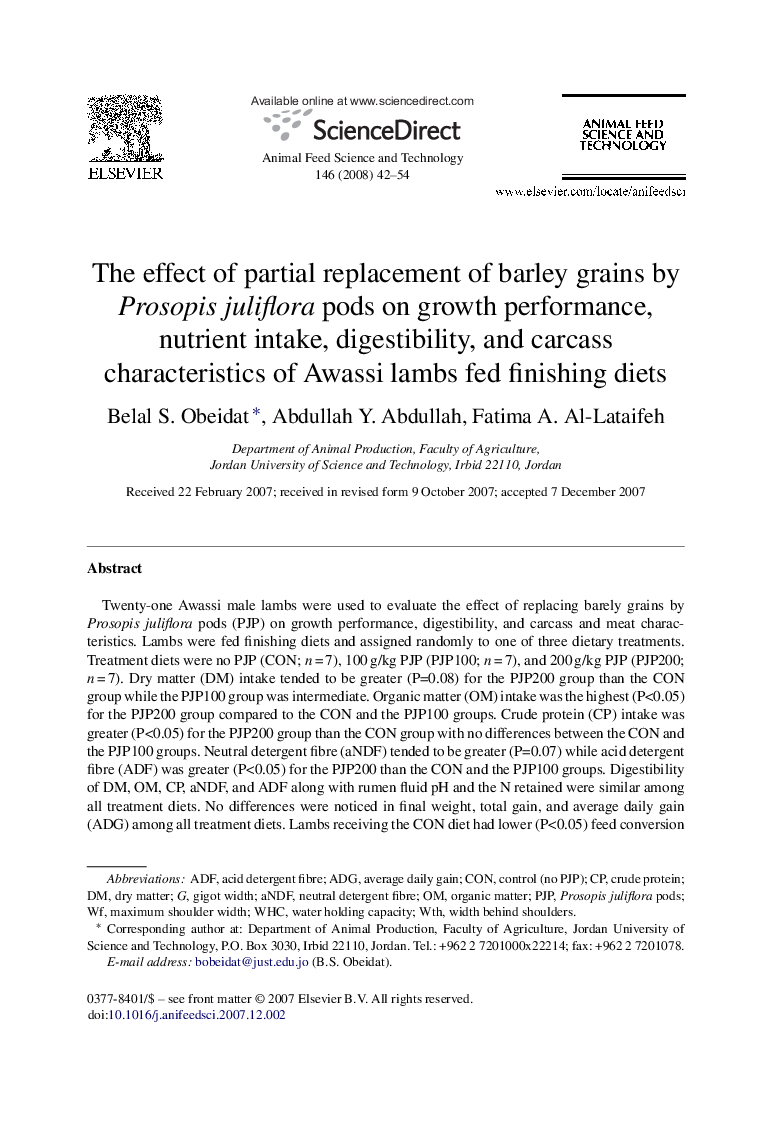| Article ID | Journal | Published Year | Pages | File Type |
|---|---|---|---|---|
| 2420758 | Animal Feed Science and Technology | 2008 | 13 Pages |
Abstract
Twenty-one Awassi male lambs were used to evaluate the effect of replacing barely grains by Prosopis juliflora pods (PJP) on growth performance, digestibility, and carcass and meat characteristics. Lambs were fed finishing diets and assigned randomly to one of three dietary treatments. Treatment diets were no PJP (CON; n = 7), 100 g/kg PJP (PJP100; n = 7), and 200 g/kg PJP (PJP200; n = 7). Dry matter (DM) intake tended to be greater (P=0.08) for the PJP200 group than the CON group while the PJP100 group was intermediate. Organic matter (OM) intake was the highest (P<0.05) for the PJP200 group compared to the CON and the PJP100 groups. Crude protein (CP) intake was greater (P<0.05) for the PJP200 group than the CON group with no differences between the CON and the PJP100 groups. Neutral detergent fibre (aNDF) tended to be greater (P=0.07) while acid detergent fibre (ADF) was greater (P<0.05) for the PJP200 than the CON and the PJP100 groups. Digestibility of DM, OM, CP, aNDF, and ADF along with rumen fluid pH and the N retained were similar among all treatment diets. No differences were noticed in final weight, total gain, and average daily gain (ADG) among all treatment diets. Lambs receiving the CON diet had lower (P<0.05) feed conversion ratio than the PJP100 and the PJP200 diets. Cost of gain was lower (P<0.05) for the PJP200 when compared to the PJP100 and the CON groups, with no differences between the CON and the PJP100 diets. No differences were observed between treatment diets in dressing percentage, hot and cold carcass weights, non-carcass components, carcass cut weights, and loin cut tissue percentages and the carcass and longissimus muscle linear measurements among treatment groups except for gigot width (G), maximum shoulder width (Wf), width behind shoulders (Wth) and eye muscle area. Gigot width, maximum shoulder width, width behind shoulders, and eye muscle area were greater (P<0.05) for the PJP200 than the CON group with no differences between the CON and the PJP100 treatment diets. Meat quality parameters measured were all comparable among the treatment diets with the exception of water holding capacity which was greater in the PJP200 group. Meat of all the treatments had similar tenderness results and within the acceptable tenderness range. These data indicate that feeding fattening Awassi lambs diets containing up to PJP200 did not affect growth performance, nutrient digestibility, and carcass and meat characteristics while being cost effective.
Keywords
Related Topics
Life Sciences
Agricultural and Biological Sciences
Animal Science and Zoology
Authors
Belal S. Obeidat, Abdullah Y. Abdullah, Fatima A. Al-Lataifeh,
